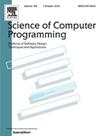Analyzing MoWebA's adaptability across architectures
IF 1.4
4区 计算机科学
Q3 COMPUTER SCIENCE, SOFTWARE ENGINEERING
引用次数: 0
Abstract
Specifying architectural properties is still an open issue for Model Driven Web Engineering to address portability, adaptability, and evolution. Several Model-Driven Web methods and methodologies consider extensions that enrich the Platform Independent Model (PIM) or the Platform Specific Model (PSM) to include elements of a particular platform or architecture. However, the degree of independence of the model is critical to achieving adaptability and evolution. Therefore, some authors have proposed a new layer called an Architecture Specific Model (ASM) to model architectural properties. Some evidence suggests that adopting ASM as an intermediate stage between PIM and PSM is a way to facilitate the evolution of web system. This paper focuses on the Architecture Specific Model (ASM) of MoWebA (Model Oriented Web Approach), and analyzes its impact on adaptability across different architectural styles. A case study is presented to validate this issue by extending MoWebA to three different architectures. In such extensions, we analyze the degree of adaptability of MoWebA and the automation of PIM-ASM, as well as the degree of independence of the PIM metamodel. In addition, through three types of questionnaire and other quantitative data, the study analyzes user satisfaction with the adoption of MoWebA.
分析MoWebA跨架构的适应性
对于模型驱动Web工程来说,指定体系结构属性仍然是一个悬而未决的问题,以解决可移植性、适应性和进化问题。一些模型驱动的Web方法和方法学考虑了丰富平台独立模型(PIM)或平台特定模型(PSM)的扩展,以包含特定平台或体系结构的元素。然而,模型的独立程度对于实现适应性和进化至关重要。因此,一些作者提出了一个称为体系结构特定模型(ASM)的新层来为体系结构属性建模。一些证据表明,采用ASM作为PIM和PSM之间的中间阶段是促进web系统发展的一种方式。本文重点研究了MoWebA(面向模型的Web方法)的体系结构特定模型(Architecture Specific Model, ASM),并分析了它对不同体系结构风格的适应性的影响。通过将MoWebA扩展到三种不同的体系结构,给出了一个案例研究来验证这个问题。在这些扩展中,我们分析了MoWebA的自适应程度和PIM- asm的自动化程度,以及PIM元模型的独立程度。此外,本研究通过三种类型的问卷调查和其他定量数据,分析了MoWebA采用的用户满意度。
本文章由计算机程序翻译,如有差异,请以英文原文为准。
求助全文
约1分钟内获得全文
求助全文
来源期刊

Science of Computer Programming
工程技术-计算机:软件工程
CiteScore
3.80
自引率
0.00%
发文量
76
审稿时长
67 days
期刊介绍:
Science of Computer Programming is dedicated to the distribution of research results in the areas of software systems development, use and maintenance, including the software aspects of hardware design.
The journal has a wide scope ranging from the many facets of methodological foundations to the details of technical issues andthe aspects of industrial practice.
The subjects of interest to SCP cover the entire spectrum of methods for the entire life cycle of software systems, including
• Requirements, specification, design, validation, verification, coding, testing, maintenance, metrics and renovation of software;
• Design, implementation and evaluation of programming languages;
• Programming environments, development tools, visualisation and animation;
• Management of the development process;
• Human factors in software, software for social interaction, software for social computing;
• Cyber physical systems, and software for the interaction between the physical and the machine;
• Software aspects of infrastructure services, system administration, and network management.
 求助内容:
求助内容: 应助结果提醒方式:
应助结果提醒方式:


